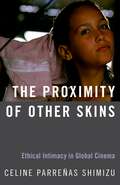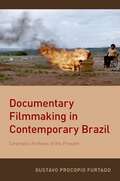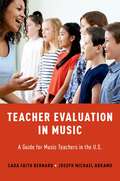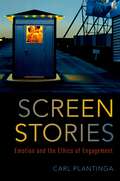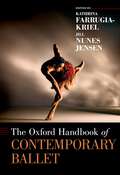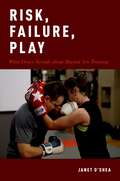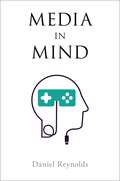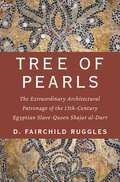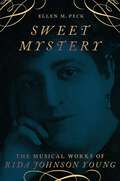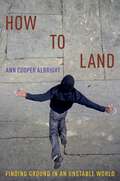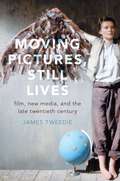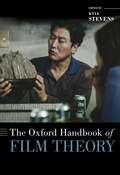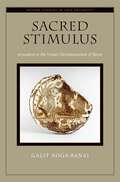- Table View
- List View
PROXIMITY OF OTHER SKINS C: Ethical Intimacy in Global Cinema
by Celine Parreñas ShimizuTransnational films that represent intimacy and inequality produce new experiences that result in the displacement of the universal spectator, in a redefinition of the power of cinema for today's global audiences. The Proximity of Other Skins examines transnational films that achieve global prominence in presenting a different cinematic language of love and sex. Author Celine Parreñas Shimizu traverses independent films by Gina Kim and Ramona Diaz to the global cinema of Laurent Cantet, Park Chan-wook and Cannes award-winning director Brilliante Mendoza and their representations of transnational intimacies. In doing so, she addresses unexpected encounters in the global movement of people and goods within their geopolitical, historical, and cultural contexts. In these celebrated films that move across continents, she finds ways to expand our definition of intimacy, including explicit sex and relations that go beyond sex, enabling us the opportunity to theorize how people now live together in many spheres of contemporary life. Readers can then better understand how intimacy can affirm and express love, but also alienate and oppress, revealing the loneliness, pain, and suffering within transnational, national, and personal relations of power and hierarchy. In studying representations of intimacy, the book calls to expand our vocabulary of moving images and its role in redefining care work and affective relations between people across difference and inequality. The book addresses cinematic intimacies between husbands/wives/lovers, understanding between sex workers and clients, close familiarity between rich and poor, and new affinities between citizen and refugee and laborer and capitalist.
Documentary Filmmaking in Contemporary Brazil: Cinematic Archives of the Present
by Gustavo Procopio FurtadoWinner of the 2020 Antonio Candido Prize for Best Book in the Humanities from the Brazil section of the Latin American Studies Association This book examines the vibrant field of documentary filmmaking in Brazil from the transition to democracy in 1985 to the present. Marked by significant efforts toward the democratization of Brazil's highly unequal society, this period also witnessed the documentary's rise to unprecedented vitality in quantity, quality, and diversity of production-which includes polished auteur films as well as rough-hewn collaborative works, films made in major metropolitan regions as well as in indigenous villages and in remote parts of the Amazon, intimate first-person documentaries as well as films that dive headfirst into struggles for social justice. The transformations of Brazilian society and of filmmaking coalesce and become entangled in this cinema's preoccupation with archives. Historically linked to the exercise and maintenance of power, the concept of the archive is critical for the documentary as a cultural practice that preserves images from the present for the future, unearths and repurposes visual materials from the past, and is historically invested in filmic images as records of the real. Contemporary films incorporate, reflect on, and rework a variety of archives, such as documents produced by official institutions, ethnographic images, home movies, and photo albums-and engage not only with what is preserved but also with lacunas in the record and with alternate forms of remembering, retrieving, and transmitting the past. Through its interaction with archives, this book argues, the contemporary documentary reflects on and intervenes in the distribution of visibilities and invisibilities, centers and margins, silences and speech, living memory and its preservation in the record-thus locating the documentary on archival borders that concern Brazilian society and filmmaking alike.
DOCUMENT FILMMAKING IN CONTEMP BRAZIL C: Cinematic Archives of the Present
by Gustavo Procopio FurtadoWinner of the 2020 Antonio Candido Prize for Best Book in the Humanities from the Brazil section of the Latin American Studies Association This book examines the vibrant field of documentary filmmaking in Brazil from the transition to democracy in 1985 to the present. Marked by significant efforts toward the democratization of Brazil's highly unequal society, this period also witnessed the documentary's rise to unprecedented vitality in quantity, quality, and diversity of production-which includes polished auteur films as well as rough-hewn collaborative works, films made in major metropolitan regions as well as in indigenous villages and in remote parts of the Amazon, intimate first-person documentaries as well as films that dive headfirst into struggles for social justice. The transformations of Brazilian society and of filmmaking coalesce and become entangled in this cinema's preoccupation with archives. Historically linked to the exercise and maintenance of power, the concept of the archive is critical for the documentary as a cultural practice that preserves images from the present for the future, unearths and repurposes visual materials from the past, and is historically invested in filmic images as records of the real. Contemporary films incorporate, reflect on, and rework a variety of archives, such as documents produced by official institutions, ethnographic images, home movies, and photo albums-and engage not only with what is preserved but also with lacunas in the record and with alternate forms of remembering, retrieving, and transmitting the past. Through its interaction with archives, this book argues, the contemporary documentary reflects on and intervenes in the distribution of visibilities and invisibilities, centers and margins, silences and speech, living memory and its preservation in the record-thus locating the documentary on archival borders that concern Brazilian society and filmmaking alike.
Teacher Evaluation in Music: A Guide for Music Teachers in the U.S.
by Cara Faith Bernard Joseph Michael AbramoTeacher Evaluation in Music: A Guide for Music Teachers in the U. S. aims to help music teachers navigate the controversial terrain of teacher evaluation. Rather than entering the debate on policy divorced from practice, this book is intended as a pragmatic approach to help music teachers to thrive within teacher evaluation systems and as a way to improve practice. Using Shulman's concept of content knowledge, general pedagogical knowledge, and pedagogical content knowledge, this book strives to help music teachers find a balance between advocating for themselves and their programs and for using teacher evaluation to improve their teaching. The book covers history of policy and law of teacher evaluation and the competing uses of teacher evaluation to rate teachers or as a professional development tool. The descriptions of policies, laws, and competing uses are approached in a way to help music teachers use teacher evaluation for their benefit to grow as professionals. This book has chapters devoted to giving detailed and specific strategies in key areas that research has suggested music teachers struggle to implement: questioning, literacy, differentiated instruction, and assessment. Complimenting these key areas are sample lesson plans which apply the strategies of questioning, differentiation, literacy, and assessment discussed in each chapter. These lessons serve as a resource and guide for teachers to develop their own lessons and improve their practice. The final chapter gives guidance on how music teachers may talk to administrators and evaluators to make teacher evaluation productive. Through these detailed descriptions of understanding teacher evaluation, talking to evaluators, and improving practice, music teachers may not just survive but thrive in these systems of accountability.
TEACHER EVALUATION IN MUSIC C: A Guide for Music Teachers in the U.S.
by Cara Faith Bernard Joseph Michael AbramoTeacher Evaluation in Music: A Guide for Music Teachers in the U. S. aims to help music teachers navigate the controversial terrain of teacher evaluation. Rather than entering the debate on policy divorced from practice, this book is intended as a pragmatic approach to help music teachers to thrive within teacher evaluation systems and as a way to improve practice. Using Shulman's concept of content knowledge, general pedagogical knowledge, and pedagogical content knowledge, this book strives to help music teachers find a balance between advocating for themselves and their programs and for using teacher evaluation to improve their teaching. The book covers history of policy and law of teacher evaluation and the competing uses of teacher evaluation to rate teachers or as a professional development tool. The descriptions of policies, laws, and competing uses are approached in a way to help music teachers use teacher evaluation for their benefit to grow as professionals. This book has chapters devoted to giving detailed and specific strategies in key areas that research has suggested music teachers struggle to implement: questioning, literacy, differentiated instruction, and assessment. Complimenting these key areas are sample lesson plans which apply the strategies of questioning, differentiation, literacy, and assessment discussed in each chapter. These lessons serve as a resource and guide for teachers to develop their own lessons and improve their practice. The final chapter gives guidance on how music teachers may talk to administrators and evaluators to make teacher evaluation productive. Through these detailed descriptions of understanding teacher evaluation, talking to evaluators, and improving practice, music teachers may not just survive but thrive in these systems of accountability.
Screen Stories: Emotion and the Ethics of Engagement
by Carl PlantingaThe way we communicate with each other is vital to preserving the cultural ecology, or wellbeing, of a place and time. Do we listen to each other? Do we ask the right questions? Do we speak about each other with respect or disdain? The stories that we convey on screens, or what author Carl Plantinga calls 'screen stories,' are one powerful and pervasive means by which we communicate with each other. Screen Stories: Emotion and the Ethics of Engagement argues that film and media studies needs to move toward an an approach to ethics that is more appropriate for mass consumer culture and the lives of its citizens. Primarily concerned with the relationship between media and viewers, this book considers ethical criticism and the emotional power of screen stories that makes such criticism necessary. The content we consume--from television shows and movies to advertisements--can significantly affect our welfare on a personal and societal level, and thus, this content is subject to praise and celebration, or questioning and even condemnation. The types of screen stories that circulate contribute to the cultural ecology of a time and place; through shared attention they influence what individuals think and feel. Plantinga develops a theory of the power of screen stories to affect both individuals and cultures, asserting that we can better respond ethically to such media if we understand the sources of its influence on us.
SCREEN STORIES C: Emotion and the Ethics of Engagement
by Carl PlantingaThe way we communicate with each other is vital to preserving the cultural ecology, or wellbeing, of a place and time. Do we listen to each other? Do we ask the right questions? Do we speak about each other with respect or disdain? The stories that we convey on screens, or what author Carl Plantinga calls 'screen stories,' are one powerful and pervasive means by which we communicate with each other. Screen Stories: Emotion and the Ethics of Engagement argues that film and media studies needs to move toward an an approach to ethics that is more appropriate for mass consumer culture and the lives of its citizens. Primarily concerned with the relationship between media and viewers, this book considers ethical criticism and the emotional power of screen stories that makes such criticism necessary. The content we consume--from television shows and movies to advertisements--can significantly affect our welfare on a personal and societal level, and thus, this content is subject to praise and celebration, or questioning and even condemnation. The types of screen stories that circulate contribute to the cultural ecology of a time and place; through shared attention they influence what individuals think and feel. Plantinga develops a theory of the power of screen stories to affect both individuals and cultures, asserting that we can better respond ethically to such media if we understand the sources of its influence on us.
The Oxford Handbook of Contemporary Ballet (Oxford Handbooks)
In distinction to many extant histories of ballet, The Oxford Handbook of Contemporary Ballet prioritizes connections between ballet communities as it interweaves chapters by scholars, critics, choreographers, and working professional dancers. The book looks at the many ways ballet functions as a global practice in the 21st century, providing new perspectives on ballet's past, present, and future. As an effort to dismantle the linearity of academic canons, the fifty-three chapters within provide multiple entry points for readers to engage in balletic discourse. With an emphasis on composition and process alongside dances created, and the assertion that contemporary ballet is a definitive era, the book carves out space for critical inquiry. Many of the chapters consider whether or not ballet can reconcile its past and actually become present, while others see ballet as flexible and willing to be remolded at the hands of those with tools to do so.
The Oxford Handbook of Contemporary Ballet (Oxford Handbooks)
by Kathrina Farrugia-Kriel Jill Nunes JensenIn distinction to many extant histories of ballet, The Oxford Handbook of Contemporary Ballet prioritizes connections between ballet communities as it interweaves chapters by scholars, critics, choreographers, and working professional dancers. The book looks at the many ways ballet functions as a global practice in the 21st century, providing new perspectives on ballet's past, present, and future. As an effort to dismantle the linearity of academic canons, the fifty-three chapters within provide multiple entry points for readers to engage in balletic discourse. With an emphasis on composition and process alongside dances created, and the assertion that contemporary ballet is a definitive era, the book carves out space for critical inquiry. Many of the chapters consider whether or not ballet can reconcile its past and actually become present, while others see ballet as flexible and willing to be remolded at the hands of those with tools to do so.
Risk, Failure, Play: What Dance Reveals about Martial Arts Training
by Janet O'SheaRisk, Failure, Play illuminates the many ways in which competitive martial arts differentiate themselves from violence. Presented from the perspective of a dancer and writer, this book takes readers through the politics of everyday life as experienced through training in a range of martial arts practices such as jeet kune do, Brazilian jiu jitsu, kickboxing, Filipino martial arts, and empowerment self-defense. Author Janet OâShea shows how play gives us the ability to manage difficult realities with intelligence and demonstrates that physical play, with its immediacy and heightened risk, is particularly effective at accomplishing this task. Risk, Failure, Play also demonstrates the many ways in which physical recreation allows us to manage the complexities of our current social reality. Risk, Failure, Play intertwines personal experience with phenomenology, social psychology, dance studies, performance studies, as well as theories of play and competition in order to produce insights on pleasure, mastery, vulnerability, pain, agency, individual identity, and society. Ultimately, this book suggests that play allows us to rehearse other ways to live than the ones we see before us and challenges us to reimagine our social reality.
RISK, FAILURE, PLAY C: What Dance Reveals about Martial Arts Training
by Janet O'SheaRisk, Failure, Play illuminates the many ways in which competitive martial arts differentiate themselves from violence. Presented from the perspective of a dancer and writer, this book takes readers through the politics of everyday life as experienced through training in a range of martial arts practices such as jeet kune do, Brazilian jiu jitsu, kickboxing, Filipino martial arts, and empowerment self-defense. Author Janet OâShea shows how play gives us the ability to manage difficult realities with intelligence and demonstrates that physical play, with its immediacy and heightened risk, is particularly effective at accomplishing this task. Risk, Failure, Play also demonstrates the many ways in which physical recreation allows us to manage the complexities of our current social reality. Risk, Failure, Play intertwines personal experience with phenomenology, social psychology, dance studies, performance studies, as well as theories of play and competition in order to produce insights on pleasure, mastery, vulnerability, pain, agency, individual identity, and society. Ultimately, this book suggests that play allows us to rehearse other ways to live than the ones we see before us and challenges us to reimagine our social reality.
Media in Mind
by Daniel ReynoldsWhere do you end, and where do media begin? In Media in Mind, author Daniel Reynolds draws upon naturalist philosophies of the mind from John Dewey through contemporary theories of embodied and extended cognition to make the case that the lines separating media from the minds of their users are not blurry or variable so much as they never existed to begin with. Through analyses of films and video games from 1900 to the present, Media in Mind shows how media forms and technologies challenge dominant models of perception and mental representation, and how they complicate theoretical understanding of concepts like the platform and the interface. In order to do justice to the profound and literally mind-changing power of media, Reynolds argues, we need to think not so much about the relationship between media and the mind as about the roles that media play in our minds. Through this crucial distinction, Media in Mind surveys more than a century of media theory to illustrate the ways that scholars of film and digital media have situated and reconsidered a series of divisions between media, user, and world, and how these conceptual divisions have reflected and inflected their ways of understanding the mind.
MEDIA IN MIND C
by Daniel ReynoldsWhere do you end, and where do media begin? In Media in Mind, author Daniel Reynolds draws upon naturalist philosophies of the mind from John Dewey through contemporary theories of embodied and extended cognition to make the case that the lines separating media from the minds of their users are not blurry or variable so much as they never existed to begin with. Through analyses of films and video games from 1900 to the present, Media in Mind shows how media forms and technologies challenge dominant models of perception and mental representation, and how they complicate theoretical understanding of concepts like the platform and the interface. In order to do justice to the profound and literally mind-changing power of media, Reynolds argues, we need to think not so much about the relationship between media and the mind as about the roles that media play in our minds. Through this crucial distinction, Media in Mind surveys more than a century of media theory to illustrate the ways that scholars of film and digital media have situated and reconsidered a series of divisions between media, user, and world, and how these conceptual divisions have reflected and inflected their ways of understanding the mind.
Tree of Pearls: The Extraordinary Architectural Patronage of the 13th-Century Egyptian Slave-Queen Shajar al-Durr
by D. Fairchild RugglesShajar al-Durr--known as "Tree of Pearls"--began her remarkable career as a child slave, given as property to the Ayyubid Sultan Salih of Egypt. She became his favorite concubine, was manumitted, became the sultan's wife, served as governing regent, and ultimately rose to become the legitimately appointed sultan of Egypt in 1250 after her husband's death. Shajar al-Durr used her wealth and power to add a tomb to his urban madrasa; with this innovation, madrasas and many other charitably endowed architectural complexes became commemorative monuments, a practice that remains widespread today. A highly unusual case of a Muslim woman authorized to rule in her own name, her reign ended after only three months when she was forced to share her governance with an army general from the ranks of the Mamluks (elite slave soldiers) and for political expediency to marry him. Despite the fact that Shajar al-Durr's story ends tragically with her assassination and hasty burial, her deeds in her lifetime offer a stark alternative to the continued belief that women in the medieval period were unseen, anonymous, and inconsequential in a world that belonged to men. This biography--the first ever in English--will place the rise and fall of the sultan-queen in the wider context of the cultural and architectural development of Cairo, the city that still holds one of the largest and most important collections of Islamic monuments in the world. D. Fairchild Ruggles also situates the queen's extraordinary architectural patronage in relation to other women of her own time, such as Aleppo's Ayyubid regent. Tree of Pearls concludes with a lively discussion of what we can know about the material impact of women of both high and lesser social rank in this period, and why their impact matters in the writing of history.
Tree of Pearls: The Extraordinary Architectural Patronage of the 13th-Century Egyptian Slave-Queen Shajar al-Durr
by D. Fairchild RugglesShajar al-Durr--known as "Tree of Pearls"--began her remarkable career as a child slave, given as property to the Ayyubid Sultan Salih of Egypt. She became his favorite concubine, was manumitted, became the sultan's wife, served as governing regent, and ultimately rose to become the legitimately appointed sultan of Egypt in 1250 after her husband's death. Shajar al-Durr used her wealth and power to add a tomb to his urban madrasa; with this innovation, madrasas and many other charitably endowed architectural complexes became commemorative monuments, a practice that remains widespread today. A highly unusual case of a Muslim woman authorized to rule in her own name, her reign ended after only three months when she was forced to share her governance with an army general from the ranks of the Mamluks (elite slave soldiers) and for political expediency to marry him. Despite the fact that Shajar al-Durr's story ends tragically with her assassination and hasty burial, her deeds in her lifetime offer a stark alternative to the continued belief that women in the medieval period were unseen, anonymous, and inconsequential in a world that belonged to men. This biography--the first ever in English--will place the rise and fall of the sultan-queen in the wider context of the cultural and architectural development of Cairo, the city that still holds one of the largest and most important collections of Islamic monuments in the world. D. Fairchild Ruggles also situates the queen's extraordinary architectural patronage in relation to other women of her own time, such as Aleppo's Ayyubid regent. Tree of Pearls concludes with a lively discussion of what we can know about the material impact of women of both high and lesser social rank in this period, and why their impact matters in the writing of history.
Sweet Mystery: The Musical Works of Rida Johnson Young (Broadway Legacies)
by Ellen M. PeckRida Johnson Young (ca. 1869-1926) was one of the most prolific female playwrights of her time, as well as a lyricist and librettist in the musical theater. She wrote more than thirty full-length plays, operettas, and musical comedies, 500 songs, and four novels, including Naughty Marietta, Lady Luxury, The Red Petticoat, and When Love is Young . Despite her extensive output, no significant study of her work has been produced. This book looks at her musical theater works with in-depth analyses of her librettos and lyrics, as well as her working relationships with other writers, performers, and producers, particularly Lee and J. J. Shubert. Using archival materials such as original typescripts, correspondence, and reviews, the book contextualizes her work in the early twentieth century professional theater and provides a window into the standard practices of writing and production of the era.
Sweet Mystery: The Musical Works of Rida Johnson Young (Broadway Legacies)
by Ellen M. PeckRida Johnson Young (ca. 1869-1926) was one of the most prolific female playwrights of her time, as well as a lyricist and librettist in the musical theater. She wrote more than thirty full-length plays, operettas, and musical comedies, 500 songs, and four novels, including Naughty Marietta, Lady Luxury, The Red Petticoat, and When Love is Young . Despite her extensive output, no significant study of her work has been produced. This book looks at her musical theater works with in-depth analyses of her librettos and lyrics, as well as her working relationships with other writers, performers, and producers, particularly Lee and J. J. Shubert. Using archival materials such as original typescripts, correspondence, and reviews, the book contextualizes her work in the early twentieth century professional theater and provides a window into the standard practices of writing and production of the era.
How to Land: Finding Ground in an Unstable World
by Ann Cooper AlbrightHow to Land: Finding Ground in an Unstable World foregrounds the importance of embodiment as a means of surviving the disorientation of our twenty-first century world. Linking somatics and politics, author Ann Cooper Albright argues that a renewed attention to gravity as both a metaphoric sensibility and a physical experience can help transform moments of personal disorientation into an opportunity to reflect on the important relationship between individual resiliency and communal responsibility. Long one of the nation's preeminent thinkers in dance studies, Albright asks how contemporary bodies are affected by repeated images of falling bodies, bombed-out buildings, and displaced peoples, as well as recurring evocations of global economies and governments in discursive free fall or dissolution. What kind of fear gets lodged in connective tissue when there is an underlying anxiety that certain aspects of our world are in danger of falling apart? To answer this question, she draws on analyses of perception from cognitive studies, tracing the discussions of meaning, body and language through the work of Sara Ahmed, Jean-Luc Nancy, and Shaun Gallagher, among others. In addition, she follows the past decade of debate in contemporary media concerning the implications of the weightless and two-dimensional social media exchanges on structures of attention and learning, as well as their effect on the personal growth and socialization of a generation of young adults. Each chapter interweaves discussions of movement actions with their cultural implications, documenting specific bodily experiences and then tracing their ideological ripples out through the world.
HOW TO LAND C: Finding Ground in an Unstable World
by Ann Cooper AlbrightHow to Land: Finding Ground in an Unstable World foregrounds the importance of embodiment as a means of surviving the disorientation of our twenty-first century world. Linking somatics and politics, author Ann Cooper Albright argues that a renewed attention to gravity as both a metaphoric sensibility and a physical experience can help transform moments of personal disorientation into an opportunity to reflect on the important relationship between individual resiliency and communal responsibility. Long one of the nation's preeminent thinkers in dance studies, Albright asks how contemporary bodies are affected by repeated images of falling bodies, bombed-out buildings, and displaced peoples, as well as recurring evocations of global economies and governments in discursive free fall or dissolution. What kind of fear gets lodged in connective tissue when there is an underlying anxiety that certain aspects of our world are in danger of falling apart? To answer this question, she draws on analyses of perception from cognitive studies, tracing the discussions of meaning, body and language through the work of Sara Ahmed, Jean-Luc Nancy, and Shaun Gallagher, among others. In addition, she follows the past decade of debate in contemporary media concerning the implications of the weightless and two-dimensional social media exchanges on structures of attention and learning, as well as their effect on the personal growth and socialization of a generation of young adults. Each chapter interweaves discussions of movement actions with their cultural implications, documenting specific bodily experiences and then tracing their ideological ripples out through the world.
Moving Pictures, Still Lives: Film, New Media, and the Late Twentieth Century
by James TweedieMoving Pictures, Still Lives revisits the cinematic and intellectual atmosphere of the late twentieth century. Against the backdrop of the historical fever of the 1980s and 1990s-the rise of the heritage industry, a global museum-building boom, and a cinematic fascination with costume dramas and literary adaptations-it explores the work of artists and philosophers who complicated the usual association between tradition and the past or modernity and the future. Author James Tweedie retraces the "archaeomodern turn" in films and theory that framed the past as a repository of abandoned but potentially transformative experiments. He examines late twentieth-century filmmakers who were inspired by old media, especially painting, and often viewed those art forms as portals to the modern past. In detailed discussions of Alain Cavalier, Terence Davies, Jean-Luc Godard, Peter Greenaway, Derek Jarman, Agnès Varda, and other key directors, the book concentrates on films that fill the screen with a succession of tableaux vivants, still lifes, illuminated manuscripts, and landscapes. It also considers three key figures-Walter Benjamin, Gilles Deleuze, and Serge Daney-who grappled with the late twentieth century's characteristic concerns, including history, memory, and belatedness. It reframes their theoretical work on film as a mourning play for past revolutions and a means of reviving the possibilities of the modern age (and its paradigmatic medium, cinema) during periods of political and cultural retrenchment. Looking at cinema and the century in the rear-view mirror, the book highlights the unrealized potential visible in the history of film, as well as the cinematic phantoms that remain in the digital age.
MOVING PICTURES,STILL LIVES C: Film, New Media, and the Late Twentieth Century
by James TweedieMoving Pictures, Still Lives revisits the cinematic and intellectual atmosphere of the late twentieth century. Against the backdrop of the historical fever of the 1980s and 1990s-the rise of the heritage industry, a global museum-building boom, and a cinematic fascination with costume dramas and literary adaptations-it explores the work of artists and philosophers who complicated the usual association between tradition and the past or modernity and the future. Author James Tweedie retraces the "archaeomodern turn" in films and theory that framed the past as a repository of abandoned but potentially transformative experiments. He examines late twentieth-century filmmakers who were inspired by old media, especially painting, and often viewed those art forms as portals to the modern past. In detailed discussions of Alain Cavalier, Terence Davies, Jean-Luc Godard, Peter Greenaway, Derek Jarman, Agnès Varda, and other key directors, the book concentrates on films that fill the screen with a succession of tableaux vivants, still lifes, illuminated manuscripts, and landscapes. It also considers three key figures-Walter Benjamin, Gilles Deleuze, and Serge Daney-who grappled with the late twentieth century's characteristic concerns, including history, memory, and belatedness. It reframes their theoretical work on film as a mourning play for past revolutions and a means of reviving the possibilities of the modern age (and its paradigmatic medium, cinema) during periods of political and cultural retrenchment. Looking at cinema and the century in the rear-view mirror, the book highlights the unrealized potential visible in the history of film, as well as the cinematic phantoms that remain in the digital age.
The Oxford Handbook of Film Theory (OXFORD HANDBOOKS SERIES)
Despite changes in the media landscape, film remains a vital force in contemporary culture, as do our ideas of what "a movie" or "the cinematic" are. Indeed, we might say that the category of film now only exists in theory. Whereas film-theoretical discussion at the turn of the 21st century was preoccupied, understandably, by digital technology's permeation of virtually all aspects of the film object, this volume moves the conversation away from a focus on film's materiality towards timely questions concerning the ethics, politics, and even aesthetics of thinking about the medium of cinema. To put it another way, this collection narrows in on the subject of film, not with a nostalgic sensibility, but with the recognition that what constitutes a film is historically contingent, in dialogue with the vicissitudes of entertainment, art, and empire. The volume is divided into six sections: Meta-Theory; Film Theory's Project of Emancipation; Apparatus and Perception; Audiovisuality; How Close is Close Reading?; and The Turn to Experience.
The Oxford Handbook of Film Theory (OXFORD HANDBOOKS SERIES)
by Kyle StevensDespite changes in the media landscape, film remains a vital force in contemporary culture, as do our ideas of what "a movie" or "the cinematic" are. Indeed, we might say that the category of film now only exists in theory. Whereas film-theoretical discussion at the turn of the 21st century was preoccupied, understandably, by digital technology's permeation of virtually all aspects of the film object, this volume moves the conversation away from a focus on film's materiality towards timely questions concerning the ethics, politics, and even aesthetics of thinking about the medium of cinema. To put it another way, this collection narrows in on the subject of film, not with a nostalgic sensibility, but with the recognition that what constitutes a film is historically contingent, in dialogue with the vicissitudes of entertainment, art, and empire. The volume is divided into six sections: Meta-Theory; Film Theory's Project of Emancipation; Apparatus and Perception; Audiovisuality; How Close is Close Reading?; and The Turn to Experience.
Sacred Stimulus: Jerusalem in the Visual Christianization of Rome (Oxford Studies in Late Antiquity)
by Galit Noga-BanaiSacred Stimulus offers a thorough exploration of Jerusalem's role in the formation and formulation of Christian art in Rome during the fourth and fifth centuries. The visual vocabulary discussed by Galit Noga-Banai gives an alternative access point to the mnemonic efforts conceived while Rome converted to Christianity: not in comparison to pagan art in Rome, not as reflecting the struggle with the emergence of New Rome in the East (Constantinople), but rather as visual expressions of the confrontation with earthly Jerusalem and its holy places. After all, Jerusalem is where the formative events of Christianity occurred and were memorialized. Sacred Stimulus argues that, already in the second half of the fourth century, Rome constructed its own set of holy sites and foundational myths, while expropriating for its own use some of Jerusalem's sacred relics, legends, and sites. Relying upon well-known and central works of art, including mosaic decoration, sarcophagi, wall paintings, portable art, and architecture, Noga-Banai exposes the omnipresence of Jerusalem and its position in the genesis of Christian art in Rome. Noga-Banai's consideration of earthly Jerusalem as a conception that Rome used, or had to take into account, in constructing its own new Christian ideological and cultural topography of the past, sheds light on connections and analogies that have not necessarily been preserved in the written evidence, and offers solutions to long-standing questions regarding specific motifs and scenes.
Sacred Stimulus: Jerusalem in the Visual Christianization of Rome (Oxford Studies in Late Antiquity)
by Galit Noga-BanaiSacred Stimulus offers a thorough exploration of Jerusalem's role in the formation and formulation of Christian art in Rome during the fourth and fifth centuries. The visual vocabulary discussed by Galit Noga-Banai gives an alternative access point to the mnemonic efforts conceived while Rome converted to Christianity: not in comparison to pagan art in Rome, not as reflecting the struggle with the emergence of New Rome in the East (Constantinople), but rather as visual expressions of the confrontation with earthly Jerusalem and its holy places. After all, Jerusalem is where the formative events of Christianity occurred and were memorialized. Sacred Stimulus argues that, already in the second half of the fourth century, Rome constructed its own set of holy sites and foundational myths, while expropriating for its own use some of Jerusalem's sacred relics, legends, and sites. Relying upon well-known and central works of art, including mosaic decoration, sarcophagi, wall paintings, portable art, and architecture, Noga-Banai exposes the omnipresence of Jerusalem and its position in the genesis of Christian art in Rome. Noga-Banai's consideration of earthly Jerusalem as a conception that Rome used, or had to take into account, in constructing its own new Christian ideological and cultural topography of the past, sheds light on connections and analogies that have not necessarily been preserved in the written evidence, and offers solutions to long-standing questions regarding specific motifs and scenes.
